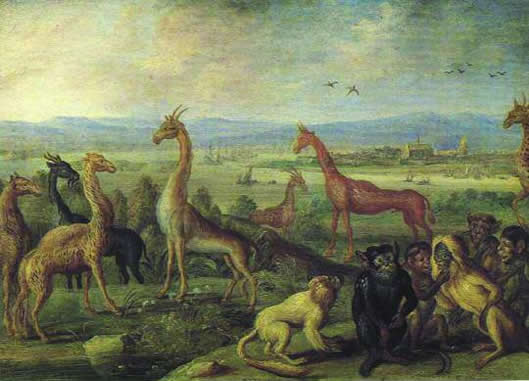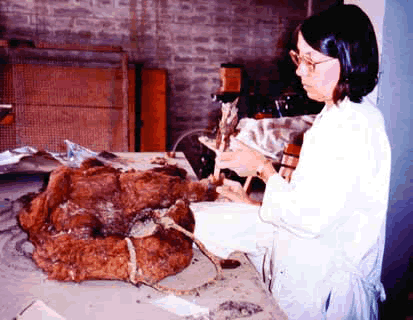By Jane C. Wheeler, Ph.D.
Almost every paper I have
written about alpaca origins has
contained a statement to the
effect that the origin of this
animal remains a matter of debate.
Curiously though, there has never
been a real debate on the matter, just
the accumulation of divergent
scientific opinions over a very long
time concerning the evolutionary
history of the South American
camelids.
The earliest published descriptions of
the alpaca date to the 1700s, when the
primary scientific interest was in
classifying and naming all plants and
animals based upon the study of physical
similarities. The foremost researcher of
the day, Carolus Linnaeus, published
numerous editions of his work Systema
Naturae, a massive catalogue describing
and classifying all plants and animals
then known to European science.
The
10th edition of Systema Naturae
appeared in 1758 and today remains the
basis for taxonomy and taxonomic
nomenclature, the classification and
naming of plants and animals
respectively. The species, or group of
animals with the greatest number of
shared physical traits, is the basic unit of
classification in the taxonomic hierarchy.
In turn, species are grouped into genera
(genus = singular), genera into families,
families into orders and orders into kingdoms, all on the basis of declining
frequency of shared traits.
For example,
the jackal (Canis aureus) and wolf (Canis
lupus) are separate species grouped in
the genus Canis, family Canidae, order
Carnivora and kingdom Mammalia.
During the 1700s information about
non-European plants and animals was
often lacking, incomplete or distorted.
European paintings of the period depict
South American camelids as long
necked, giraffe-like beasts complete with
horns, together with camel-like, deerlike
and even dog-like forms. None the
less, Linnaeus described the alpaca with
precision as Camelus pacos “Camelus
peruvianus laniger Pacos dictus”, placing
it together with the llama Camelus lama“Camelus peruvianus Glama dictus”, the
dromedary Camelus dromedarius and
the Bactrian camel Camelus bactrianus
in the genus Camelus. The wild South
American camelids were unknown to

Painting by Jan Van Kessel: SANTO DOMINGO. 1664-1666
(Munich, Alte Pinakothik)
Linnaeus and subsequently described by
P.L.S. Müller, who in 1776 described the
guanaco as Camelus guanicoe and J.I.
Molina, who in 1782 described the
vicuña as Camelus vicugna. In 1800, the
French scientist G. Cuvier, separated the
New and Old World camelids into Lama
and Camelus in his compendium of
plant and animal species.
It was not until the mid-1800s, and the
discoveries of Charles Darwin, that the
relationship between taxonomic
classification, based on the physical
appearance of plants and animals, and
evolutionary history was recognized.
Darwin utilized a tree to illustrate the
evolution of species through “descent
with modification”, and in most cases,
the taxonomic nomenclature of the
1700s fitted the evolutionary
relationships depicted on those trees.
Nonetheless, the genetic basis of the
process remained unknown until Gregor
Mendel’s discovery of the laws of
heredity (1856-1863) became public
knowledge in 1900. Since that date,
genetics has played an ever more
important role in the study of
evolutionary relationships between
species, and with the discovery and
development of DNA based research,
molecular genetics now represents the
most powerful tool ever for
documenting evolutionary history at
individual, population and species levels.
Although it is now possible to determine
the origin of species with absolute
certainty, taxonomic classification has
often been slow to incorporate the new
molecular data perpetuating confusion
about scientific names and the implied
evolutionary relationships in many
species.
Until 1800, the alpaca, llama, guanaco,
vicuña, dromedary and Bactrian were
classified in the same genus, Camelus,
reflecting a common ancestry. In 1800,
the alpaca, llama, guanaco and vicuña
were removed from Camelus and placed
in the genus Lama. In 1924 Miller
separated the vicuña from the other
South American camelids creating the
genus Vicugna. These classifications
imply that alpaca, llama and guanaco
form a single group within which the
guanaco would be the ancestral form,
while the vicuña is a separate never
domesticated wild species.
Over the years a series of hypotheses
have been put forward concerning
alpaca origins. The oldest, even
predating Molina’s formal published
description of vicuña in 1782, is that the
alpaca descends from the vicuña and the
llama from the guanaco. The second,
and until recently dominate theory,
holds that both the alpaca and the llama
descend from the guanaco and the
vicuña was never domesticated. The
third, now discredited theory dated to
the 1930s, held that wild alpacas and
llamas existed during the last Ice Age in
Argentina and that these were the
ancestors of the domestic forms, while
the vicuña and guanaco were never
brought under human control. The
fourth theory, based on the study of
behavior in zoo animals, holds that the
alpaca is a product of hybridization
between llama and vicuña.
The central theme in the debate about
alpaca origins has been whether or not
the vicuña ever was, or could be,
domesticated. Starting in the 1950s,
German scientists W. Herre, M. Röhrs
and M. Fallat argued on the basis of
changes in skull structure, brain size and
skin follicle pattern in the domestic
llama and alpaca, that the vicuña was
never brought under human control and
that the alpaca was a breed of llama
selected for fiber production. In the
1980s, J.C. Wheeler argued that changes
in incisor conformation found at
Telarmachay Rock Shelter in the central
Peruvian highlands indicated a vicuña to
alpaca domestication 6-7,000 years ago.
Analysis of hemoglobin and amino acid
sequences from zoo animals in Germany
(1980-90s) and Chile (1960) produced
evidence both for and against vicuña
domestication, while immunological and
protein-sequencing data from studies in
the United Sates (1980-90s) was
inconclusive. Faced with such
contradictory evidence concerning
alpaca origins, resolution of the debate
appeared impossible until the mid 1980s
when advances in DNA technology
accelerated analytical capability to the
point that the study of DNA became
routine and genome mapping possible.
By 2001, a draft of the full human
genome sequence was published, and
maps of domestic animal genomes are
now underway. Genes of commercial interest have been identified (wool
fineness in sheep, milk quality in cattle)
and DNA analysis has been used to
reconstruct the history of sheep, cattle
and horse domestication, as well as for
the characterization of breeds and
parentage testing for studbook
registries.
Clearly DNA analysis would provide
the key to resolve the alpaca origin
debate, and in 1991 Helen F. Stanley of
the Institute of Zoology, London, and I
joined forces to work on this problem
while I was at the Macaulay Land Use
Research Institute in Edinburgh.
Unfortunately we had a limited number
of samples available to us for study, so
the real value of our work was in
establishing the laboratory protocols for
the study of South American camelid
DNA, and sequencing the entire
mitochondrial cytochrome b gene. In
1994, together with Miranda Kadwell,
we published the first camelid molecular
sequence in the Proceedings of the
Royal Society London B. Unfortunately,
however, the results concerning alpaca
origins were inconclusive. We had
chosen to study mitochondrial DNA
because its frequent mutations made it
an ideal tool for studying evolutionary
relationships, but since it is maternally
inherited, and thus represents only half
of the genetic history of an individual, it
cannot be used for this purpose when
hybridization has occurred.
And
considerable evidence of hybridization
between Lama and Vicugna was
precisely what we found. So although
our results verified the genus level
separation of vicuña and guanaco, and
dated that separation to between two
and three million years ago, they did not
resolve the question of alpaca origins.
So it was back to the drawing board,
time to improve our sample set and time
to study nuclear DNA, which is
inherited from both parents, with
research grants from the U.K.
Department of the Environment and the
U.K. Darwin Initiative for Survival of
Species making it possible. Since 1994,
Michael W. Bruford of Cardiff
University and Jane C. Wheeler have
headed a team of U.K. and Peruvian
researchers working on many aspects of
South American camelid genetics and in
2001 they published an article in the Proceedings of the Royal Society London B (268(1485):2575-
2584), which finally resolved the question of alpaca origins.
Utilizing both mitochondrial (maternally inherited) and
nuclear microsatellite (bi-parentally inherited) DNA and more
than 700 South American camelid samples collected
throughout the Andes, their results demonstrated the validity
of the proposed genus level division between guanaco (Lama)
and vicuña (Vicugna), as well as the ancestral relationship
between guanaco and llama and the vicuña and alpaca. Change
of the taxonomic nomenclature for the South American
camelids has now been accepted so that the guanaco and llama
are Lama guanicoe and Lama glama, respectively, and the
vicuña and alpaca are Vicugna vicugna and Vicugna pacos,
reflecting the different origins of the domestic forms.
Determining the origin of the alpaca has been a difficult
undertaking due to massive hybridization with llamas. In our
2001 publication we found 80% of the Andes wide alpaca
sample set were crosses, and in 2004 the results of continued
research in Canchis Province, Cusco, found the figure to be 92
percent. Such levels of hybridization must lie at the heart of
the debate about alpaca origins since most of the animals
studied by scientists were certainly crosses. Fortunately,
however, molecular genetics has made it possible to identify
the hybrids and the question of alpaca origins is no longer a
matter of debate.
CQ

Jane C. Wheeler studying 1,300 year old llama mummy from the site
of El Yaral, Moquegua, Peru.
About the
Author
Jane Wheeler is Vice President for Research, CONOPA (Coordinadora de
Investigación y Desarrollo de Camélidos Sudamericanos), Lima, Perú,
jwheeler@conopa.org. She holds degrees from American University,
Cambridge University, and the University of Michigan, and completed
postdoctoral studies at the University of Paris. For more than 30 years she
has conducted broad based research on the South American camelids,
covering topics from origin, evolution and domestication of alpacas and
llamas, to molecular genetics, breeding and fibre production, as well as
vicuña and guanaco genetics and conservation. |

